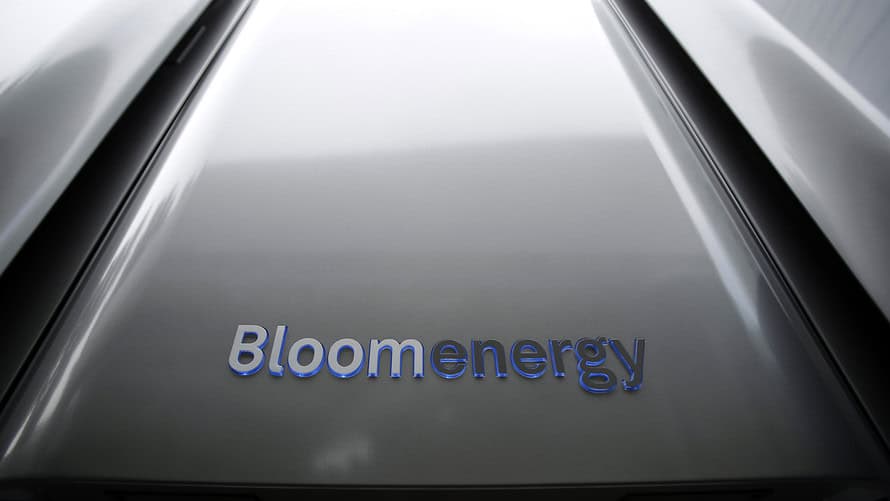
Stock down 20% after guidance is trimmed
Shares of clean-energy provider Bloom Energy Corp. fell 20% Tuesday, after the company reported a wider-than-expected loss for the third quarter and trimmed guidance for the fourth quarter.
The company BE, +1.62% makes fuel cells that are used in stationary power-generation services to convert natural gas or biogas into electricity. It went public in July with some fanfare, racking up a 67% gain on its first day of trade.
Analysts have generally taken a bullish view of the company, which claims a major advantage over other alternative energy providers in that it provides a constant current of power, unlike wind or solar that have downtimes. But the stock has floundered after the initial euphoria as investors weigh up risks that include competition from lower utility rates as more renewables are incorporated and a potential shortage of scandium, a rare-earth metal used as an electrolyte.
The company late Monday posted a net loss of $78.6 million, or 97 cents a share, in the quarter, wider than the $71.8 million loss, or $6.97 a share, posted in the year-earlier period. The stark difference in the two loss-per-share numbers stems from the fact that the IPO took place during the quarter, boosting the company’s share count to 81.3 million from 10.3 million a year ago.
The company’s adjusted per-share loss came to 13 cents, better than the 17 cents loss consensus of FactSet analysts. But FactSet was expecting a net loss of just $56 million. The company said that number was weighed down by $72 million of stock-based compensation expenses related to the IPO.
In case you missed it: Bloom Energy IPO: 5 things to know about the Silicon Valley clean-energy ‘unicorn’
Revenue rose to $190.2 million from $93.8 million, beating the FactSet consensus of $186 million.
But acceptances, or actual deployments, of 206 were below guidance of 213 to 235, due to project delays. The company only books revenue at the time of system commissioning, moving it out of its backlog and onto the profit and loss account. On its earnings call, the company described a “perfect storm” — literally, referring to delays caused by hurricanes on the east coast and wildfires in California, as well as strikes and other delays at some its utility clients.
Bloom is now expecting fourth-quarter acceptances of between 225 and 275, the midpoint of which is lower than it was originally expecting. That’s because one anticipated order and acceptance has been pushed to the first quarter of 2019, Chief Financial Officer Randy Furr told analysts on the call, according to a FactSet transcript.
“When you review all the steps we go through to get the site commissioned, much of it is outside the control of Bloom,” he said. “The process almost always includes approvals from customer, landlord, local city government for building permits, and the gas and electrical utilities.”
The construction phase includes multiple inspection approvals, which are also outside the company’s control, he said: “Bottom line is predicting the timing of acceptances accurately can be difficult.”
JPMorgan analysts said the company needs to improve forecasting, “and do a better job of de-risking guidance to cultivate investor loyalty, but revenue and EBITDA is delayed, not lost, and the firm still seems positioned to achieve roughly 30% gross margins (with introduction of Gen 7.5 servers) and roughly 30% revenue compound average growth rate,” analysts led by Paul Coster wrote in a note.
JPMorgan is sticking with its overweight rating on the stock, but lowered its price target to $30 from $32.
Oppenheimer maintained its perform rating on the stock, but lowered estimates given the soft guidance. Analysts said investors were likely prepared for higher stock-based compensation costs but may have been surprised by quite how high they were.
Furr said many of the company’s employees had stock options with a strike price that was far above the IPO price. The average strike price for options issued since 2011 was $29.71, compared with an IPO price of $15.
To retain that talent, the company issued more options with up to two-year vesting “that was for all practical purposes a true-up accounting for the difference in the strike price and the IPO price,” said Furr. The company is expecting those true-up grants to reduce to zero by 2020.
“We continue to be bullish on adoption of decentralized power assets and microgrids and BE’s product positioning, but remain on the sidelines as business cycles become better understood,” said Oppenheimer.
Cowen analysts cut their stock price target to $20 from $24 on the report, but stuck with a market perform rating. They are not expecting projects delayed in the third quarter to commence in the current one, given construction blackout periods during the holiday season.
Cowen views biogas as a significant opportunity for Bloom, which is hoping to use what is emitted from landfills, wastewater treatment plants and agriculture to power the systems.
“We see this as a significant opportunity for Bloom Energy to diversify their product offering portfolio and broaden their customer base,” analysts wrote in a note.
KeyBanc analysts struck a bullish tone, reiterating their overweight rating at $27 price target. Analysts described the report as mixed, but supportive of a growth trajectory
“We are perhaps more disappointed with the free cash flow push-out as BE likely grapples with timing issues related to delivery,” they wrote in a note. “That said, per our follow-up, we are comfortable with timing elements and lumpy construction mandates.”
Bloom shares are down 34% in the last three months, while the S&P 500 SPX, +0.90% has fallen 3.6% and the Dow Jones Industrial Average DJIA, +0.69% has gained 0.3%.


